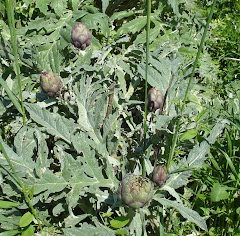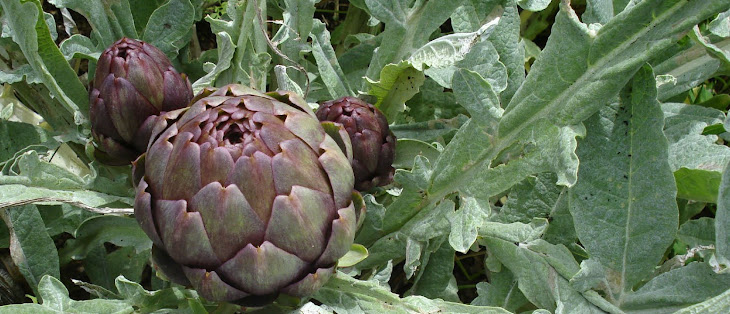 Before we lived here all the time, at the beginning of each stay we used to be overcome by the choice of food available in the shops and markets and we'd buy far too much, take it home and wonder how we were going to eat it all. We still get a bit carried away sometimes, tempted to try some of everything in case it's not there again next week.
Before we lived here all the time, at the beginning of each stay we used to be overcome by the choice of food available in the shops and markets and we'd buy far too much, take it home and wonder how we were going to eat it all. We still get a bit carried away sometimes, tempted to try some of everything in case it's not there again next week.
There's a nice blog I visit sometimes called Feast with Bron where Bron tells us what she cooks with the food she buys in Borough Market in London. Here in Gabian we have everything we need in the village. This morning the market was rather depleted by the unexplained absence of the vegetable stall - which luckily we didn't need this week as we have plenty in the garden. The fish and charcuterie stalls were enough for us.
I'm not very keen on bony varieties of fish - except for mackerel and sardines whose flavour makes the fuss worthwhile, I think. Lo Jardinièr loves most kinds of fish. Pas de problème - he has fish, while I have something from the charcuterie stall. Today he bought a marbré (according to Alan Davidson in Poisson de Méditerranée, this is the Roussillon name for this fish, but it's used here in the Languedoc too, in English it's Striped Bream). We also bought some galères, crayfish (which I do like), which I'll mention later in this post. The fish, as I've mentioned before, comes from Valras-plage, so fresh it's often still alive when it arrives here.

At the charcuterie stall we bought some sheep's cheese, butter, sausage, some pork ribs (plat de côtes) (these weren't for today, but for the next few days!). I bought some merguez, spicey lamb sausages, for my lunch. All these came from well within 100 kilometres of Gabian, up in the mountains to the north.
After several days of heavy rain (again!) it was a treat to be able to take our lunch to the garden. Lo Jardinièr barbecued the fish and merguez, with slices of courgettes I'd cut from the plants just minutes earlier, skewers of onion and bayleaf, and some skewered garlic cloves (left in their skins, which burn leaving a delicious soft clove inside). We ate these with a salad of leaves and herbs I'd just picked from the garden and decided this really is paradise!
courgettes and onions ready to barbecue

salad of lettuce, rocket, oregano, savoury and garlic
The white wine came from Domaine des Pascales in Gabian and the red from Domaine Estève in Roquessels a few kilometres away. All the ingredients for our lunch came from Gabian or very near, except the olive oil (Spanish) and the coffee (Italian). We're very lucky to have such an abundance of good things.

crayfish
In the evening we cooked the crayfish - just boiled them for five minutes, then took them out of their spikey shells and ate them with mayonnaise, potatoes from the garden and oignons doux (sweet onions). The crayfish were sweet too, but still nothing to rival my favourite crustaceans, the giant prawns which are called gambas here. I had gambas cooked in a very southern way in a restaurant the other day, flambéed in pastis. I'm going to try this at home soon.




 though it's still difficult to imagine them being black and sweet as they should be by the end of August.
though it's still difficult to imagine them being black and sweet as they should be by the end of August.




































